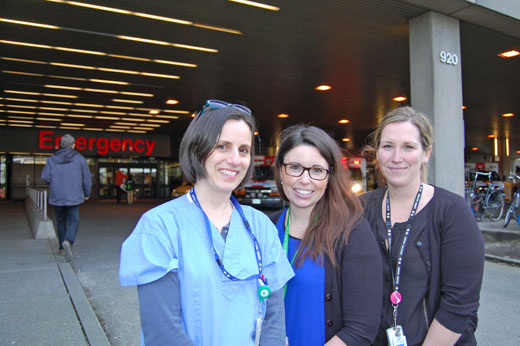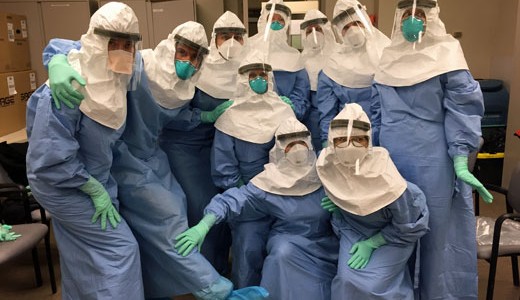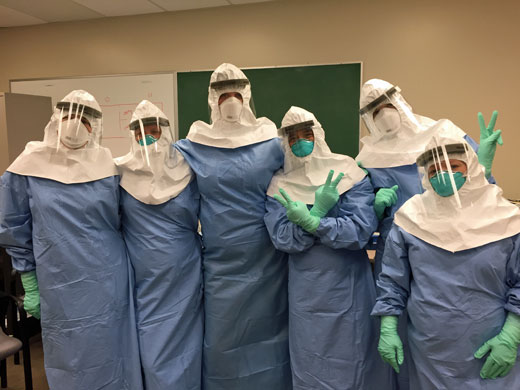Breaking bad for Ebola
Looking around the room, Alexia Simeoni couldn’t help thinking of the popular television series “Breaking Bad.” She and her colleagues were decked out in blue gowns. Faces shielded, hands gloved, and shoes in booties, they were protected from head to toe.
“We looked like a room full of Walter Whites or extras from a world-is-going-to-end-from-a-deadly-virus movie,” says the VGH Emergency Department (ED) registered nurse.
But, Alexia isn’t an actor and she wasn’t wearing a costume. She and her ED colleagues were in training to prepare for the extremely unlikely by very real possibility that a patient with Ebola will arrive at VGH.
VGH an Ebola testing facility

VGH ED Ebola Training Team (l to r): Angie Brisson, clinical nurse educator, Krista Golden, registered nurse, and Cassie Wright, project coordinator.
Surrey Memorial Hospital is the Lower Mainland’s designated site for treating patients with the Ebola virus, but that doesn’t mean we couldn’t see patients with Ebola at VGH says, Lori Korchinski, ED patient services manager.
“Our ED is responsible and equipped to assess, screen and test transferred patients — or walk-ins — with Ebola-like symptoms,” she explains. “To date, we’ve had two suspected cases arrive at the ED, but fortunately both patients tested negative.”
Although Ebola has all but disappeared from the headlines, the potential for infection remains, says Dr. Liz Bryce, regional medical director, infection control.
“Since November, we’ve had anywhere from three to seven to people — mostly health care workers returning from affected areas — under monitoring in B.C. each week. Given the situation in West Africa, we expect this to continue until at least the end of 2015.”
Hands-on training builds confidence
The intensive training Alexia and her fellow ED nurses and physicians participated in was primarily hands-on. In training sessions, staff practiced the step-by-step safe techniques for putting on and removing (also referred to as donning and doffing) the highest level of personal protective equipment in accordance with national protocols.
“In the ED, where we’re always pressed for time, it’s against our nature to slow down,” says Angie Brisson, clinical nurse educator, “but that’s exactly what we must do if a patient presents with Ebola symptoms.”
The training gave staff practical, hands-on experience completing the meticulous seven-page checklist for donning and doffing, as well as newfound confidence, adds Cassie Wright, project coordinator.
“As a nurse, proper training is essential,” says Alexia. “Feeling like you’re prepared to care for a potential Ebola patient allows you to focus 100 per cent on providing the best possible care to the patient.”
Dr. Matt Bouchard agrees. “With this real-time, hands-on practice, the expert nurses were able to convince me that myself, and our ED team were being adequately protected. I can’t stress how important this is to being able to devote adequate attention to a sick and potentially highly infectious patient.”
For Ben Gillespie, caring for patients with airborne infections isn’t out of the norm, but, he admits, the protocol for “suiting up” to care for an Ebola patient is more intense than he anticipated. “It’s a lot work and it was a cool experience overall,” says the registered nurse.
“I feel confident that we’re ready to handle any patient who may arrive with Ebola.”
Training for ED staff and physicians is ongoing. Contact Angie Brisson to learn more.
Resources
Infection Control: Ebola/Viral Hemorrhagic Fever


